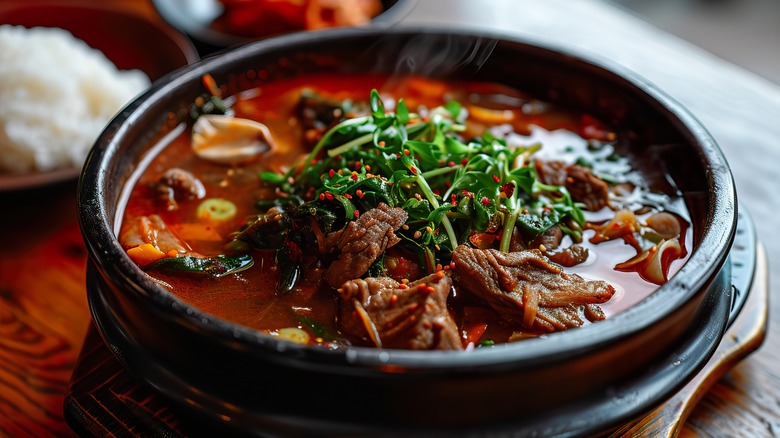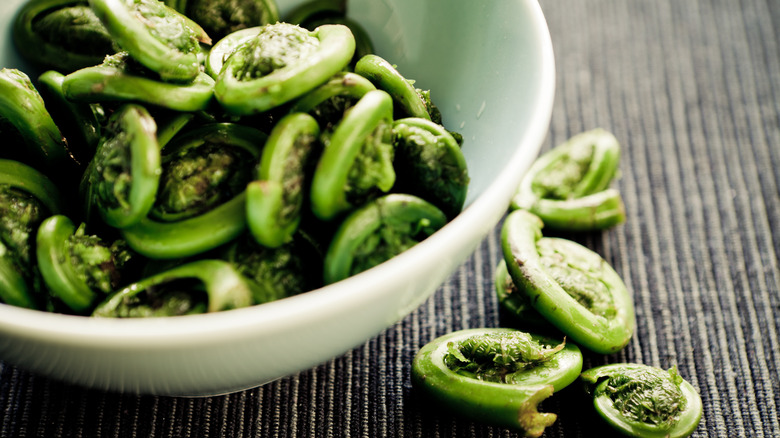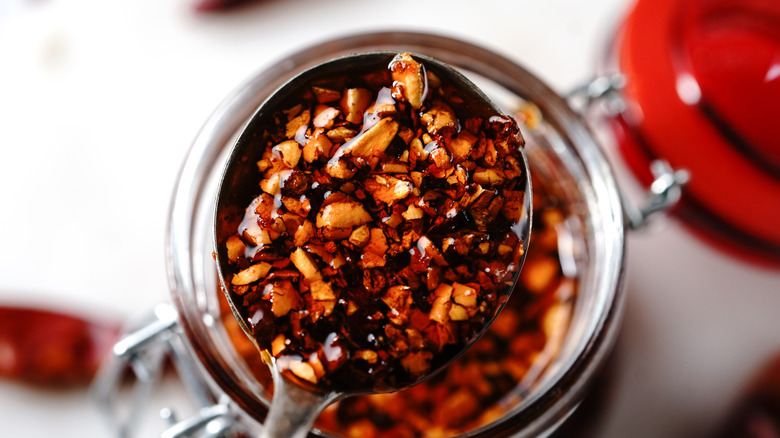The 3 Key Ingredients You Need When Making Korean Beef Stew
Korean cuisine has produced numerous iconic dishes from ultra-crispy fried chicken to Korean barbecue beef bulgogi. Another popular beef dish in Korea that you might not know is yukgaejang, a spicy beef stew bursting with umami, aromatics, and plenty of heat. We interviewed Korean cuisine expert, Chef Ji Hye Kim, a James Beard Award semi-finalist and owner of Miss Kim in Ann Arbor for insight on the defining characteristics of Korean beef stew.
"Even though beef is now the most popular version," Kim explains, "you can find this type of soup 'gaejang' made with chicken (dakgaejang) or with mushrooms from buddhist temples (busut gaejang)." However, these ingredients aren't what distinguish the stew. It's the seasonings and accompaniments that will set yukgaejang apart from other stewed beef dishes like the gochujang glazed short rib stew, galbi-jjim. Chef Kim lists three key ingredients that no spicy beef stew can be without: Fiddlehead ferns, green onions, and chili oil. With the help of Chef Kim, we'll go into the specifics of each ingredient, where to find them, or how to make them at home.
Gosari: Fiddlehead ferns
Gosari is the Korean word for bracken fiddlehead ferns, the beautiful spring vegetable known for their whimsical, spiral shape. "I think most people familiar with yukgaejang will definitely name gosari (bracken fiddlehead ferns) as the defining ingredient for this dish," Ji Hye Kim says.
Fiddlehead ferns have a tender yet firm texture akin to cooked broccoli stalks, and a taste that can be described as a cross between asparagus and green beans. Their appearance alone is enough to elevate beef stew, not to mention their sweet, grassy flavor. Fiddlehead ferns are a fleeting crop with a narrow window for peak freshness. If you have trouble finding fiddlehead ferns at your local grocery stores, Chef Kim told us that "you can find it easily in the fridge section of H-Mart or any Korean grocery stores."
That said, even specialty stores may not have fresh fiddlehead ferns during the winter or fall. So, you can also purchase dried gosari. Be advised that dried gosari requires a time consuming rehydration process involving boiling and an overnight soak before incorporating them in your beef stew.
Daepa: Large green onions
Green onions, or scallions, are a key part of many Asian-inspired stir fry dishes, wherein the white roots are fried as an aromatic foundation and the delicate green stalks are diced and sprinkled over the finished product as a garnish. They may be ubiquitous aromatic vegetables in dishes around Asia, but Chef Ji Hye Kim thinks they're especially indispensable to yukgaejang.
"Along with gosari, I love to use copious amounts of daepa, or large green onions," Kim says. "It is exactly like regular sized green onions or scallions, only bigger and perhaps a touch sweeter." They are as girthy as leeks, with long, wispy green stalks like regular scallions, so you can use both parts of the scallion.
"I get daepa at Korean grocery stores," she explains, "but more often than not I use extra amounts of regular scallions or even leeks." Leeks have the sweetness and size of large scallions, but smaller scallions possess the edible green parts that are also used in the dish. You could thus use a mixture of leeks and scallions. While leeks will create a sweet complement to the spicy chili oil and umami-rich beef, they're "a bit less tender than daepa, so I just give it a bit more time" in the stock pot. They'll also tenderize and amplify in flavor the longer they simmer with the other ingredients.
Korean chili oil
If you look up recipes for yukgaejang, they're translated into English as "spicy beef stew," and the ingredient responsible for this spicy designation is chili oil. And not just any chili oil will do. "I would not use a store-bought chili oil for this dish," Chef Ji Hye Kim advises, "As store-bought chili oils often include spices or other aromatics that are not always suitable for yukgaejang." Thus, you should save your Momofuku chili oil to drizzle over your favorite type of dumplings.
"It's super easy and simple to make chili oil for this dish," Kim continues. "I just saute minced onions and scallions in neutral oil like canola, then add gochugaru (Korean chili flakes) and minced garlic until the oil becomes red and fragrant (as opposed to brown, burnt and acrid). This quickly made chili oil provides the base and a major flavor profile for yukgaejang." You can buy gochugaru online if it isn't available at your local grocery store.
If you've ever fried garlic or onions, you know they take mere minutes to become fragrant, and the same applies for chili oil. You can toss the cooked and shredded beef and veggies in chili oil and gochujang before adding them back to the stew pot to simmer in soy sauce and broth.



